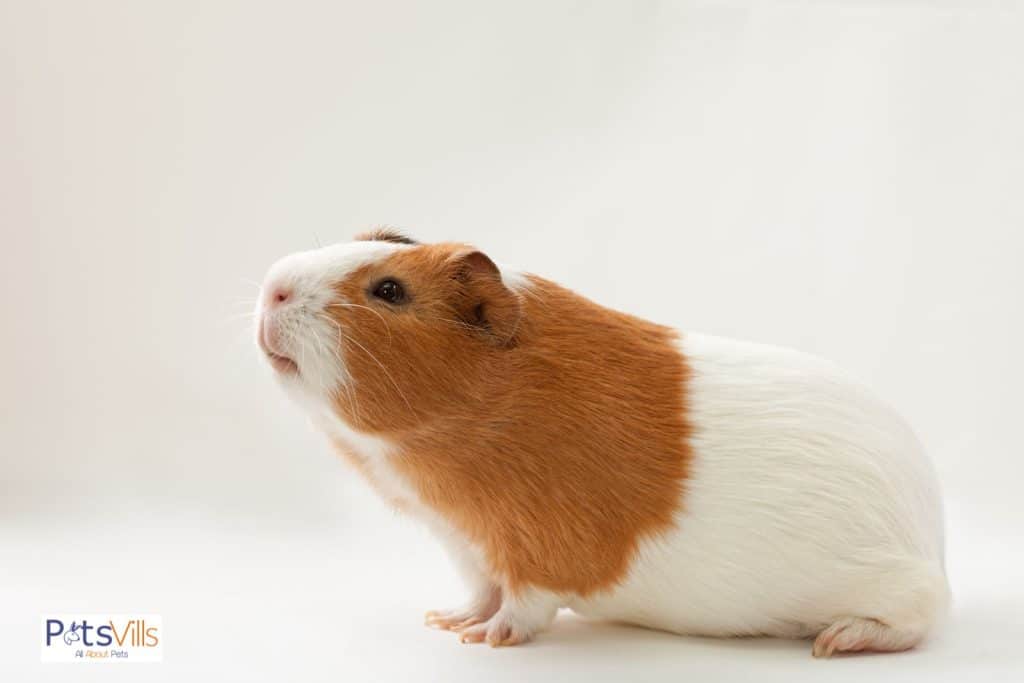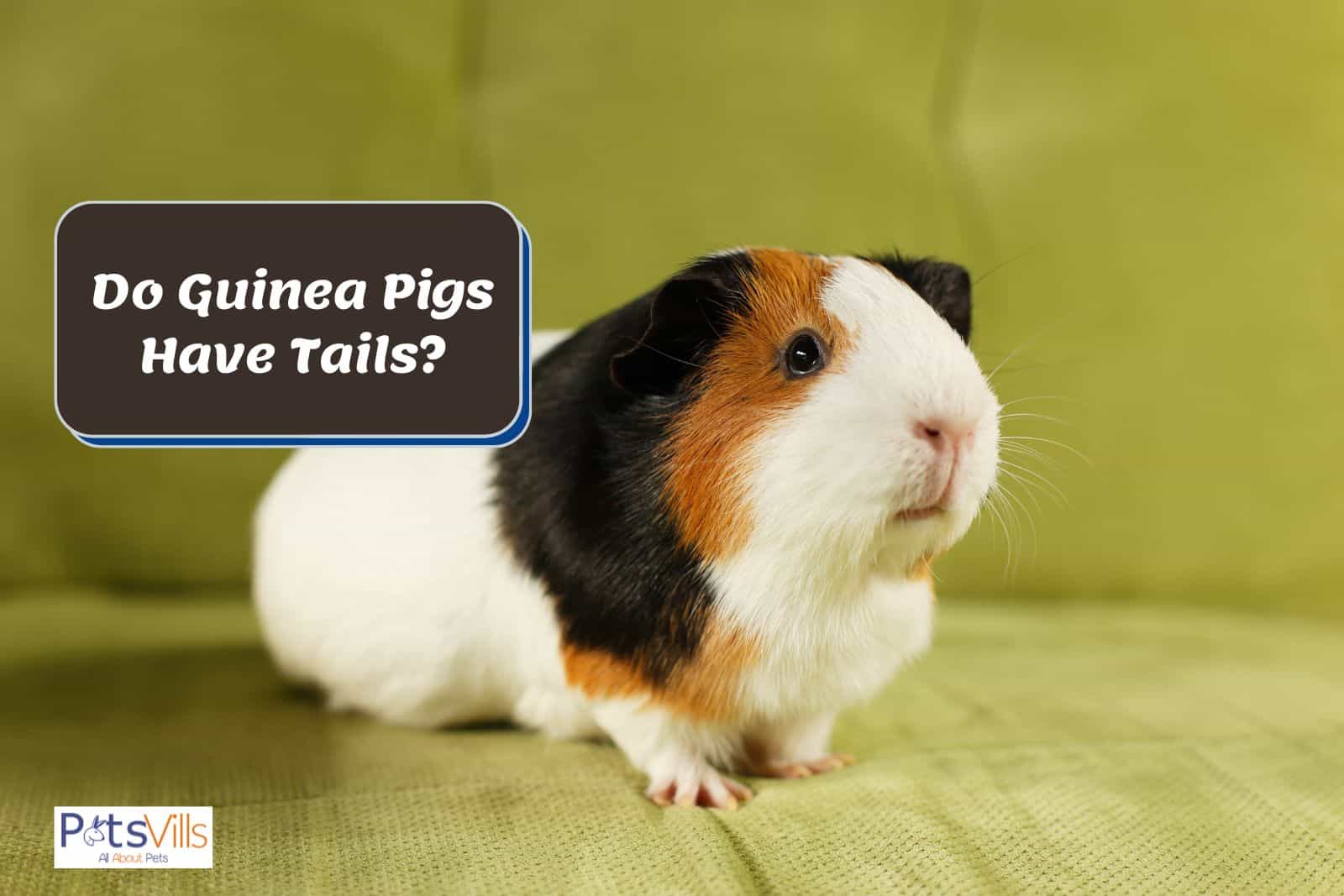One of the most curious questions about guinea pigs is whether they have tails. So I decided to answer once and for all: Do guinea pigs have tails?
According to experts, these animals don’t have tails like other rodents (1). But some rough-haired breeds will appear to have them due to cowlicks.
In this article, I’ll take you through why tails aren’t necessary for them, whether they always didn’t have one, and offer some care/maintenance tips.
Table of Contents
Quick Summary:
- Guinea pigs, also called cavies, don’t have external tails because there isn’t a practical reason to have them. It was a part of their evolution to lose them.
- Ancestral guinea pigs likely had long tails like their fellow rodents, but it made them easy to catch predators. So the shorter tail passed on until it became a vestigial tail.
- Lacking a real tail doesn’t stop guinea pigs from having tail bones. These critters have seven tail bones within their skeletal structure.
- Brushing the tailbone area is an essential part of keeping your cavy healthy. It’ll allow owners to be more aware of ticks, mites, or other health-related issues.
Why Doesn’t Your Guinea Pig Have a Tail?
It’s a logical assumption to think pet guinea pigs do have tails. For instance, many rodents have long, visible tails, like rats or squirrels.
So why don’t cavies have them? Well, it stems from the simple fact of them not needing tails to thrive and survive.

I didn’t find this realization surprising, given how my cavy typically acts. There isn’t any situation where a tail would benefit a male or female guinea pig.
Additionally, these pets are part of a family of rodents called Caviidae. In this rodent family, “there are 18 species…including maras, cavies, and guinea pigs” (2).
You can expect every species inside the Caviidae family to be native to South America. It’s also why many pet lovers refer to guinea pigs as cavies.
In any case, many Caviidae members, including guinea pigs, have vestigial tails (3). It describes when an animal has become hidden/lost due to their evolutionary pattern.
As a result, these furballs have evolved to where a real tail wasn’t necessary.
CHECK: 82 Interesting Fun Facts About Guinea Pigs
Did Guinea Pigs Always Lack a Tail?
This question was the next one on your mind when I mentioned evolution. I also found myself intrigued when first researching whether cavies had tails.
In doing so, I found something interesting, as most experts believe their ancestors may have had long and visible tails (4). So it’d be much like other rodents’ tails, such as a rat.
But it’s easy to see how a tail would’ve caused them severe problems in the wild. A bigger predator could’ve grabbed onto them and made the guinea pig their next snack.
So cavies with shorter tails survived, passing on their genes. So it continued until cavies ended up with none at all.
In the end, I don’t think guinea pigs miss these tails, as they’re doing fine and thriving without them.
Does Your Guinea Pig Have Tail Bones?
Lacking an external tail doesn’t stop these pets from having tail bones. In fact, there are seven tail bones in the guinea pig anatomy.
But owners won’t see them as they don’t stick out on healthy guinea pigs. So instead, these bones are hidden under the skin/fur and remain invisible.

In this way, it’s not too different from human tail bones. You won’t see them unless you look for them or something is wrong.
Peruvians and other rough-coated guinea pig breeds are different. These cavies can trick their owners as it may seem like they have tails.
But it’s only cowlicks forming a fake tail in your pet’s coat. It’s not an actual formation of one or connected to any bones in their spinal cord structure.
Are There Any Tailbone Care Tips?
Caring for your cavy will require some routine maintenance of their tailbone area. I’d recommend always sticking with regular vet checkups to ensure everything is alright.
Meanwhile, regular brushing of this area can help prevent a tail-like appearance. So anyone who is over against their cavy having a “tail” will need to groom this area.
This brushing is also a healthy bonding experience between you and your cavy. It’s always nice to build that relationship in whatever way possible.
Furthermore, it allows you to check for any irregularities. These grooming sessions can help you identify issues like mites or ticks before it becomes a massive concern.
Other Care Tips
A cavy’s tailbone area isn’t the only one that’ll require upkeep. Here’s a quick list of some other care tips to help ensure you can take the best care of your cavy:
- Clip their nails whenever necessary: Shorter nails are crucial to providing them with the best comfort and health circumstances possible.
- Maintain a good playpen and enclosure: These articles on what to put in guinea pig playpens and guinea pig cage cleaning will help prevent issues.
- Offer them extensive exercise and mental stimulation: Your cavy needs some entertainment in their lives, so make sure to provide it. Otherwise, it could lead to behavioral issues you don’t want to experience.
Anyone who wants a visual guide about guinea pig care should check out this video.
READ MORE: Why Do Guinea Pigs Sneeze?
FAQs
What happens if you pick a guinea pig up by its tail?
Guinea pigs don’t have tails, so picking them up by a tail is impossible. But please, don’t pick them up by the fur in their tailbone area, either.
What animals don’t have tails?
Aside from guinea pigs, some other tail-less animals include apes, humans, and most invertebrates.
Conclusion
Do guinea pigs have tails? These pets don’t have seeable tails like other similar rodents or species. Instead, they have vestigial tails that remain hidden.
Owners won’t notice them unless their cavy is malnourished or suffering from another issue. So it’s vital to routinely check on the tailbone area to ensure there’s nothing wrong.

So, did you ever see any cavy with a tail? Let us know in the comments section!
Resources
- 1. Guinea pig [Internet]. Smithsonian’s National Zoo. 2019. Available from: https://nationalzoo.si.edu/animals/guinea-pig
- 2. Caviidae – cavies, guinea pigs, maras | Wildlife Journal Junior [Internet]. nhpbs.org. Available from: https://nhpbs.org/wild/caviidae.asp
- 3. Caviidae – an overview | ScienceDirect Topics [Internet]. www.sciencedirect.com. [cited 2022 Nov 15]. Available from: https://www.sciencedirect.com/topics/biochemistry-genetics-and-molecular-biology/caviidae
- 4. Guinea-zilla? World’s Largest Rodent Identified As Ancient Sibling To Guinea Pigs [Internet]. ScienceDaily. [cited 2022 Nov 15]. Available from: https://www.sciencedaily.com/releases/2003/09/030922063618.htm

My name is Ben Roberts, and I absolutely love animals. So, naturally, I love writing about them too! As far as my animals, I have a Pit-bull, a Beagle-lab mix, a Chihuahua, and one old cat. Each one of them provides me with a new adventure every day. And the best part is they’re all best friends. Well, except the cat when he gets a little annoyed.
FIND HIM ON: FACEBOOK and TWITTER.
Read his latest ARTICLES
Learn more about Benhere


